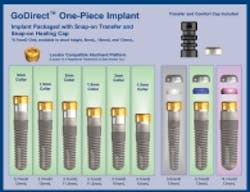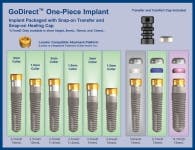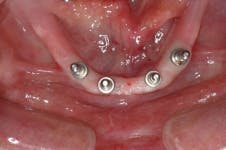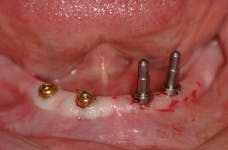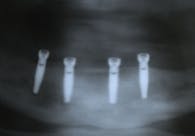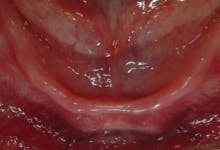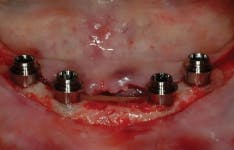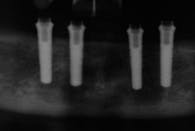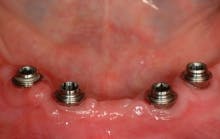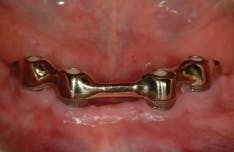Restoration of the totally enentulous jaw with application-specific one-piece implants
by Gerald A. Niznick, DMD, MSD
For more on this topic, go to www.dentaleconomics.com and search using the following key words: overdenture attachments, edentulous, implants, Dr. Gerald Niznick.
Editor's Note: This is the second of a four-part article covering the past, present, and future of dental implants and their impact on the practice of general dentistry. The second installment discusses the treatment of the totally edentulous jaw.
The highest benefit, lowest risk application for dental implants is the restoration of the totally edentulous lower jaw with two to three freestanding implants to retain an overdenture. The problem of denture stability gets progressively worse with time because of ridge resorption under the pressures of a denture. The Core-Vent implant and attachment was the first system (1982) to address this problem in a surgically simple and cost-effective way, using two freestanding implants and a snap overdenture attachment. This solution is now considered minimum standard of care by the American College of Prosthodontists. While there are a variety of overdenture attachments available for dental implants, the Zest Locator Attachment has emerged as the most popular, primarily due to its low profile and ability to accommodate nonparallel implants. This attachment is sold by most major implant companies, but the cost of the Locator Abutment, in combination with any of the implants from the major implant companies, pushes the hardware cost for the minimum number of implants (two) to about $1,000. The recommended number for denture stability is three implant/attachments with the middle one providing indirect retention to prevent the denture from flipping up in the back when the patient bites in the front. The use of four implants with overdenture attachments provides even better denture stability.
Implant Direct's GoDirect implant (Pat. Pend.) combines the body of a tapered screw implant with mini-threads and a Locator compatible abutment platform. Unlike traditional mini-implants of under 3.0 mm D with ball attachments, the GoDirect starts at 3.0 mm D and includes a 3.7 mm D and 4.7 mm D option, providing increased strength and surface area with a natural emergence profile to a wider platform. Its tapered body allows the 3.0 mm D implant to be inserted into a bone socket prepared to as small as 2.3 mm D in soft bone and 2.8 mm D in dense bone. This accommodates narrow ridges and facilitates flapless surgical techniques, especially in combination with image guided surgery. Implant Direct will soon launch the GoDirect Prosthetic System ("GPS") with both a low profile cap attachment and one that combines rotational and vertical stress-breaking features.
The ultimate goal of implant dentistry is to replace missing teeth in the most natural way. While overdenture attachments like the Locator, Ball, and GPS can provide cost-effective ways to stabilize a removable complete prosthesis, the original Branemark protocol called for splinting four to six implants in the anterior region of the edentulous mandible or maxilla with a prosthesis that could be removed only by the dentist.
Processing denture teeth to a metal superstructure retained by fixation screws is called a "fixed-detachable" or "hybrid" prosthesis. A trend has emerged for treating edentulous jaws with only four implants placed in the anterior with the distal implants angled toward the distal to reduce the extent of the cantilevers. This "all-on-4" concept of placing the minimum number of required implants can lead to a "none-on-3" result that will be far more costly to deal with than just placing an extra implant or two at the time of surgery, and eliminating the need to angle the distal implants to increase the AP spread.
All-on-4 advocates claim that this type of treatment plan reduces cost and saves treatment time, but with the introduction of the ScrewIndirect one-piece implant that provides the implant, abutment, comfort cap, and transfer at a fraction of the cost of the implant alone from all the major implant companies, the economics argument for using the minimum number of implants is no longer valid. The ScrewIndirect screw-receiving platform allows splinting of implants that have up to 40 degree divergence, allowing distal angulations of up to 20 degrees if desired. Placement of five implants in the lower symphysis and six anterior to the maxillary sinuses can be relatively straight and still support adequate length of distal cantilevers. Four ScrewIndirect implants can also be placed, as shown below, splinted with a distal attachment for retention of an overdenture, but providing the patient with a fixed-detachable prosthesis that eliminates the need for a removable prosthesis is a more natural solution to restoring an edentulous jaw.
The ScrewIndirect one-piece implant offers a 3.0 mm D implant with adequate strength. All four diameter options (3.0 mm, 3.7 mm, 4.7 mm and 5.7 mm) have the same 5 mm D multi-unit platform. The 3.0 mm D implant allows treatment of narrow ridges and simplifies accurate placement during flapless surgery. Providing teeth in one day to edentulous patients and immediate implant placement following extractions is becoming the treatment of choice. The patient's existing denture is converted to a fixed-detachable prosthesis immediately following implant placement. This is accomplished by attaching titanium sleeves to the implants that project through holes cut in the denture and attached them to the denture with cold-cure acrylic followed by shortening the denture flanges.
Dr. Gerald Niznick graduated from the University of Manitoba Dental School in 1966 and then earned a master's degree in prosthodontics at Indiana University in 1968. He has been awarded 36 U.S. patents and received honorary doctorate degrees. Reach him at [email protected].
